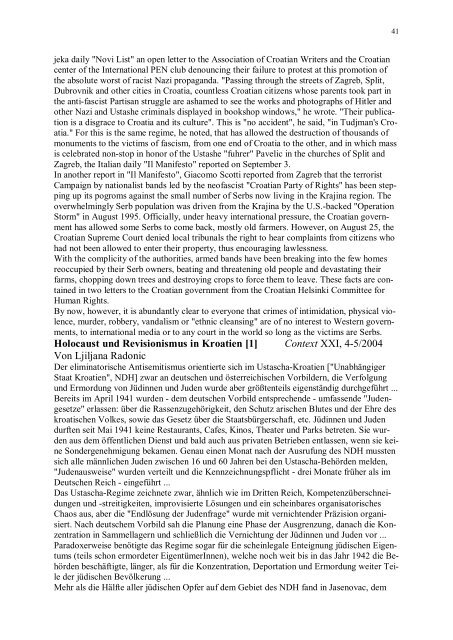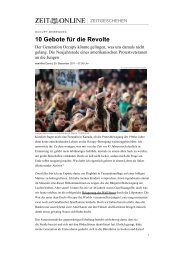JU-I (Amselfeldrede –Izetbegovic –Tudjman) 1. Ich ... - Labournet
JU-I (Amselfeldrede –Izetbegovic –Tudjman) 1. Ich ... - Labournet
JU-I (Amselfeldrede –Izetbegovic –Tudjman) 1. Ich ... - Labournet
Sie wollen auch ein ePaper? Erhöhen Sie die Reichweite Ihrer Titel.
YUMPU macht aus Druck-PDFs automatisch weboptimierte ePaper, die Google liebt.
jeka daily "Novi List" an open letter to the Association of Croatian Writers and the Croatian<br />
center of the International PEN club denouncing their failure to protest at this promotion of<br />
the absolute worst of racist Nazi propaganda. "Passing through the streets of Zagreb, Split,<br />
Dubrovnik and other cities in Croatia, countless Croatian citizens whose parents took part in<br />
the anti-fascist Partisan struggle are ashamed to see the works and photographs of Hitler and<br />
other Nazi and Ustashe criminals displayed in bookshop windows," he wrote. "Their publication<br />
is a disgrace to Croatia and its culture". This is "no accident", he said, "in Tudjman's Croatia."<br />
For this is the same regime, he noted, that has allowed the destruction of thousands of<br />
monuments to the victims of fascism, from one end of Croatia to the other, and in which mass<br />
is celebrated non-stop in honor of the Ustashe "fuhrer" Pavelic in the churches of Split and<br />
Zagreb, the Italian daily "Il Manifesto" reported on September 3.<br />
In another report in "Il Manifesto", Giacomo Scotti reported from Zagreb that the terrorist<br />
Campaign by nationalist bands led by the neofascist "Croatian Party of Rights" has been stepping<br />
up its pogroms against the small number of Serbs now living in the Krajina region. The<br />
overwhelmingly Serb population was driven from the Krajina by the U.S.-backed "Operation<br />
Storm" in August 1995. Officially, under heavy international pressure, the Croatian government<br />
has allowed some Serbs to come back, mostly old farmers. However, on August 25, the<br />
Croatian Supreme Court denied local tribunals the right to hear complaints from citizens who<br />
had not been allowed to enter their property, thus encouraging lawlessness.<br />
With the complicity of the authorities, armed bands have been breaking into the few homes<br />
reoccupied by their Serb owners, beating and threatening old people and devastating their<br />
farms, chopping down trees and destroying crops to force them to leave. These facts are contained<br />
in two letters to the Croatian government from the Croatian Helsinki Committee for<br />
Human Rights.<br />
By now, however, it is abundantly clear to everyone that crimes of intimidation, physical violence,<br />
murder, robbery, vandalism or "ethnic cleansing" are of no interest to Western governments,<br />
to international media or to any court in the world so long as the victims are Serbs.<br />
Holocaust und Revisionismus in Kroatien [1] Context XXI, 4-5/2004<br />
Von Ljiljana Radonic<br />
Der eliminatorische Antisemitismus orientierte sich im Ustascha-Kroatien ["Unabhängiger<br />
Staat Kroatien", NDH] zwar an deutschen und österreichischen Vorbildern, die Verfolgung<br />
und Ermordung von Jüdinnen und Juden wurde aber größtenteils eigenständig durchgeführt ...<br />
Bereits im April 1941 wurden - dem deutschen Vorbild entsprechende - umfassende "Judengesetze"<br />
erlassen: über die Rassenzugehörigkeit, den Schutz arischen Blutes und der Ehre des<br />
kroatischen Volkes, sowie das Gesetz über die Staatsbürgerschaft, etc. Jüdinnen und Juden<br />
durften seit Mai 1941 keine Restaurants, Cafes, Kinos, Theater und Parks betreten. Sie wurden<br />
aus dem öffentlichen Dienst und bald auch aus privaten Betrieben entlassen, wenn sie keine<br />
Sondergenehmigung bekamen. Genau einen Monat nach der Ausrufung des NDH mussten<br />
sich alle männlichen Juden zwischen 16 und 60 Jahren bei den Ustascha-Behörden melden,<br />
"Judenausweise" wurden verteilt und die Kennzeichnungspflicht - drei Monate früher als im<br />
Deutschen Reich - eingeführt ...<br />
Das Ustascha-Regime zeichnete zwar, ähnlich wie im Dritten Reich, Kompetenzüberschneidungen<br />
und -streitigkeiten, improvisierte Lösungen und ein scheinbares organisatorisches<br />
Chaos aus, aber die "Endlösung der Judenfrage" wurde mit vernichtender Präzision organisiert.<br />
Nach deutschem Vorbild sah die Planung eine Phase der Ausgrenzung, danach die Konzentration<br />
in Sammellagern und schließlich die Vernichtung der Jüdinnen und Juden vor ...<br />
Paradoxerweise benötigte das Regime sogar für die scheinlegale Enteignung jüdischen Eigentums<br />
(teils schon ermordeter EigentümerInnen), welche noch weit bis in das Jahr 1942 die Behörden<br />
beschäftigte, länger, als für die Konzentration, Deportation und Ermordung weiter Teile<br />
der jüdischen Bevölkerung ...<br />
Mehr als die Hälfte aller jüdischen Opfer auf dem Gebiet des NDH fand in Jasenovac, dem<br />
41



